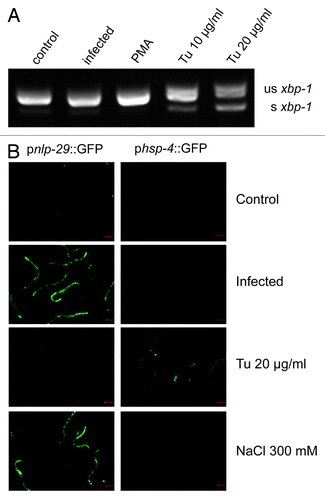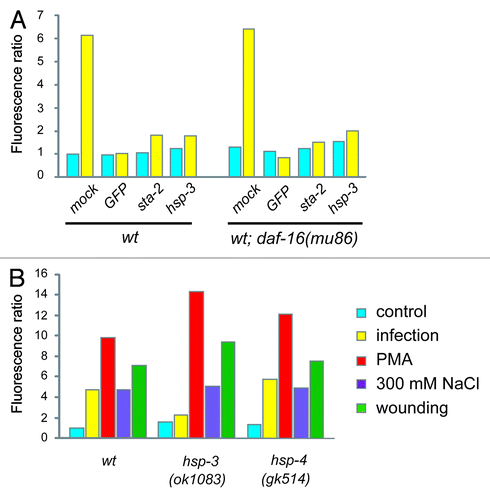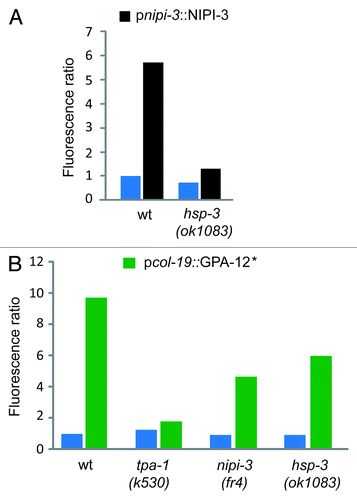Figures & data
Table 1. Protein identification from narrow pH (4–7) gel
Table 2. Protein identification from broad pH (3–10) gel
Table 3. List of identified proteins from spots with different intensities
Table 4. Functional classification by EASE of differentially represented proteins
Figure 1. Fungal infection of adult worms does not induce a UPR. (A) RT-PCR analysis of xbp-1 splicing. Under standard culture conditions (control), a 220 bp amplicon from an unspliced (us) xbp-1 transcript is detected, together with very low levels of a 197 bp amplicon from a spliced (s) transcript. The abundance of this smaller band does not increase after infection with D. coniospora (infection) or PMA treatment (PMA), but is clearly increased upon UPR-induction with tunicamycin (Tu). (B) The green fluorescence in transgenic worms carrying a pnlp-29::GFP (strain IG274; left column) or a phsp-4::GFP (IG1320; right column) reporter was observed after infection, exposure to tunicamycin, or high salt. While infection and osmotic stress induced high level of pnlp-29::GFP expression, tunicamycin induced phsp-4::GFP.

Figure 2. A specific role for hsp-3 in the regulation of nlp-29. (A) Quantification of the effect of control (K04G11.3), GFP, hsp-3 and sta-2 RNAi on pnlp-29::GFP expression in a wild-type or daf-16(mu86) mutant background. For reasons given elsewhere,Citation5 in this and the subsequent graphs, error bars are not shown. Data are representative of three independent experiments. (B) Quantification of pnlp-29::GFP expression in hsp-3(ok1083) and hsp-4(gk514) mutant backgrounds following different treatments. In all cases, quantification was with the COPAS Biosort. The normalized average ratio of green to red fluorescence is shown. The analysis was restricted to worms with a TOF above 450. The number of worms analyzed here and in subsequent figures is given in the Supplemental Material.

Figure 3.hsp-3 acts genetically downstream of nipi-3 but not of gpa-12. (A) pnlp-29::GFP reporter expression was quantified in wt and hsp-3(ok1083) mutant worms with (black bars) or without (blue bars) copies of a transgene containing nipi-3 under the control of its own promoter. (B) Quantification of pnlp-29::GFP reporter expression in wt, tpa-1(k530), nipi-3(fr4) and hsp-3(ok1083) mutant worms with (green bars) or without (blue bars) copies of a transgene containing a gain-of-function (*) allele of gpa-12 under the control of the epidermis-specific col-19 promoter. Both pnipi-3::NIPI-3 and pcol-19::GPA-12* transgenes provoke a robust nlp-29 upregulation in the absence of infection in adult worms. Quantification was with the COPAS Biosort. The normalized average ratio of green fluorescence to time of flight (TOF) is shown. The analysis was restricted to worms with a TOF between 450 and 650.

Figure 4. Model of the control of nlp-29 expression. Signals perceived upon D. coniospora infection and injury are transduced by a PKCδ - p38 MAPK pathway to regulate the expression of nlp-29. HSP-3 functions between NIPI-3 and the PKCδ TPA-1. Many other known regulatory elements, including the OSM-11/WNK-1/GCK-3 pathwayCitation48 and the recently described pseudokinase NIPI-4Citation49 have been omitted for the sake of clarity.
